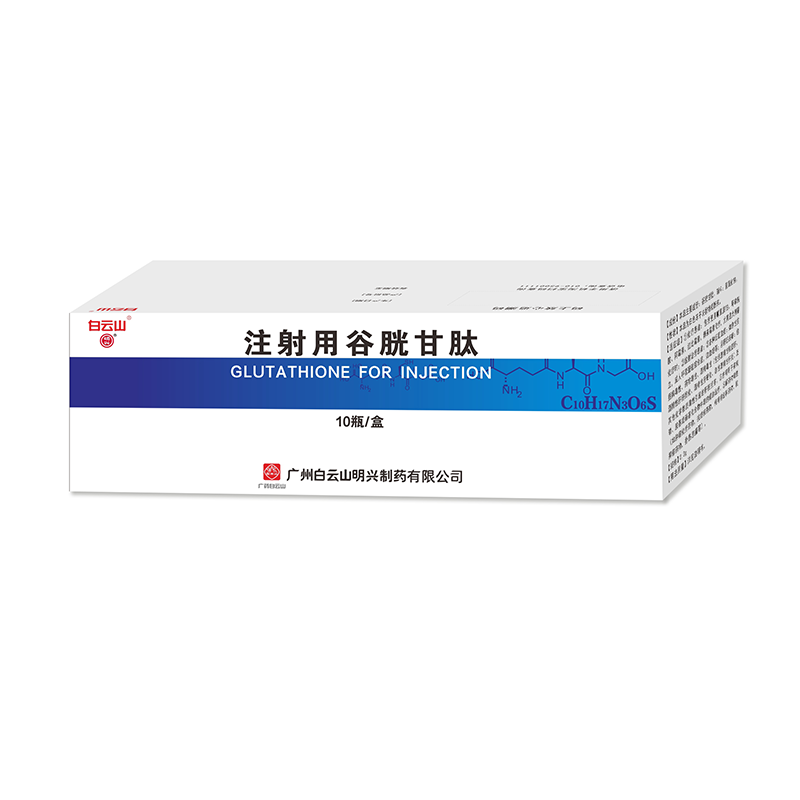Glutathione for Injection
英文名:Glutathione for Injection
汉语拼音:Zhusheyong Guguanggantai
[Drug name]
Generic name: Glutathione for injection
English name: Glutathione for Injection
Chinese Pinyin: Zhusheyong Guguanggantai
[Ingredients]
The main ingredient of this product: glutathione.
Chemical name: N-(N-L-γ-glutamyl-L-cysteinyl) glycine
Molecular formula: C10H17N3O6S
Molecular weight: 307.32
Excipients: Sodium hydroxide
[Properties]
This product is a white freeze-dried block or powder.
[Indications] ① Chemotherapy patients: including chemotherapy with cisplatin, cyclophosphamide, doxorubicin, erythromycin, bleomycin, especially high-dose chemotherapy; ② Radiotherapy patients; ③ Various hypoxemias: such as acute anemia, adult respiratory distress syndrome, sepsis, etc.; ④ Liver diseases: including liver damage caused by viruses, drug toxicity, alcohol toxicity (including alcoholic fatty liver, alcoholic liver fibrosis, alcoholic cirrhosis, acute alcoholic hepatitis) and other chemical substances. ⑤ It can also be used as an adjuvant treatment for poisoning by organophosphorus, amino or nitro compounds. ⑥ Antidote for drug toxicity (such as tumor chemotherapy drugs, anti-tuberculosis drugs, psychiatric neurology drugs, antidepressants, paracetamol, etc.).
[Specifications] ① 0.3g; ② 0.6g
[Usage and Dosage] 1. Administration route: ① Intravenous injection: After dissolving it in water for injection, add 100ml, 250~500ml of normal saline or 5% glucose injection and drip it intravenously. ②Intramuscular injection: Dissolve it in water for injection and inject it intramuscularly. 2. Dosage: ① Patients undergoing chemotherapy: Dissolve 1.5g/m2 of this product in 100ml of normal saline or 5% glucose injection within 15 minutes before giving chemotherapy drugs, and infuse it intravenously within 15 minutes. On the 2nd to 5th day, inject 0.6g of this product intramuscularly every day. When using cyclophosphamide (CTX), in order to prevent damage to the urinary system, it is recommended to inject this product intravenously immediately after the injection of CTX, and complete the infusion within 15 minutes; when using cisplatin chemotherapy, it is recommended that the dosage of this product should not exceed 35mg/mg cisplatin, so as not to affect the chemotherapy effect. ②Adjuvant treatment of liver diseases. For viral hepatitis, 1.2g, qd, iv, 30 days; severe hepatitis: 1.2~2.4g, qd, iv, 30 days; active cirrhosis: 1.2g, qd, iv, 30 days; fatty liver: 1.8g, qd, iv, 30 days; alcoholic hepatitis: 1.8g, qd, iv, 14~30 days; drug-induced hepatitis: 1.2~1.8g, qd, iv, 14~30 days. ③ For radiotherapy adjuvant medication, after irradiation, the dose is 1.5g/m², or follow the doctor's advice. ④ Other diseases: such as hypoxemia, 1.5g/m² of this product can be dissolved in 100ml of normal saline for intravenous infusion. After the condition improves, 0.3~0.6g can be injected intramuscularly every day to maintain. 3. Treatment course: liver disease generally has a course of 30 days, and other conditions are determined according to the condition.
【Adverse reactions】
Adverse reactions/events found in post-marketing monitoring of drugs include:
Damage to the skin and its appendages: rash, itching, increased sweating, urticaria, maculopapular rash, flushing;
Damage to the respiratory system: dyspnea, shortness of breath, cough, asthma;
Systemic damage: pale face, chest pain, chills, fever, high fever, allergic reaction, anaphylactic shock;
Gastrointestinal damage: loss of appetite, nausea, vomiting, abdominal pain, stomach pain;
Nervous system damage: dizziness, headache;
Damage to the medication site: pain at the injection site, phlebitis at the injection site;
Cardiovascular system damage: decreased blood pressure, abnormal pulse, palpitations.
【Contraindications】
This product is contraindicated in patients with allergic reactions to it.
【Precautions】①Use this product in the hospital under the supervision of a doctor. ②It must be completely dissolved before injection, and the appearance must be clear and colorless. ③Put it out of reach of children. ④Intramuscular injection is limited to use when this route of administration is required, and repeated injections at the same site should be avoided. ⑤This drug can cause anaphylactic shock. Doctors should ask patients about their history of drug allergies and monitor closely during medication. If symptoms and signs such as rash, pale complexion, abnormal pulse, asthma, chest tightness, shortness of breath, dyspnea, palpitations, sweating, and decreased blood pressure occur, the drug should be discontinued immediately and treated in time. ⑥Patients with a history of asthma attacks should use with caution.
[Drug use in pregnant and lactating women] This experiment has not been conducted and there are no reliable references.
[Drug use in children] Newborns, premature infants, infants and children should use the drug with caution, especially intramuscular injection.
[Drug use in the elderly] Elderly patients should appropriately reduce the dosage of the drug and be closely monitored during medication.
[Drug interactions] This product should not be mixed with vitamin B12, vitamin K3 (sodium menadione bisulfite), calcium pantothenate, orotic acid, antihistamines, sulfonamides and tetracycline.
[Drug overdose] There have been no reports of drug overdose. If drug overdose occurs, symptomatic treatment should be given.
[Pharmacology and Toxicology] Glutathione is a tripeptide containing sulfhydryl (SH) that is widely found in nature. It is mainly found in the cytoplasm and plays a role in various cellular life functions. Glutathione is a cofactor of glyceraldehyde phosphate dehydrogenase, and a coenzyme of glyoxalase and triose phosphate dehydrogenase. It participates in the tricarboxylic acid cycle and sugar metabolism in the body. It can activate SH enzymes in the body and promote the metabolism of carbohydrates, fats and proteins. Glutathione can also combine with free radicals in the body through sulfhydryl groups to promote the formation of easily metabolized low-toxic compounds, so it has a detoxifying effect on some exogenous poisons.
[Pharmacokinetics] Mice reach the peak blood concentration in about 5 hours after intramuscular injection, and the t1/2 is about 24 hours. Data show that after intravenous injection of 35S-GSH in animals, GSH is well distributed in various organs in a very short time, especially in the liver, kidney, skin and spleen. Although the distribution of radioactivity per unit body weight in the heart, skeletal muscle and brain is not high, its elimination from these organs is also slow. Within seven days after injection, 24±4.2% of the radioactivity is excreted in the urine.
[Storage] Sealed, below 25°C, stored in a dry place.
[Packaging] Glass controlled injection bottle, 10 bottles/box.
[Validity period] 24 months
[Approval number] ① National Medicine Standard H20183334 (0.3g)
② National Medicine Standard H20183335 (0.6g)
